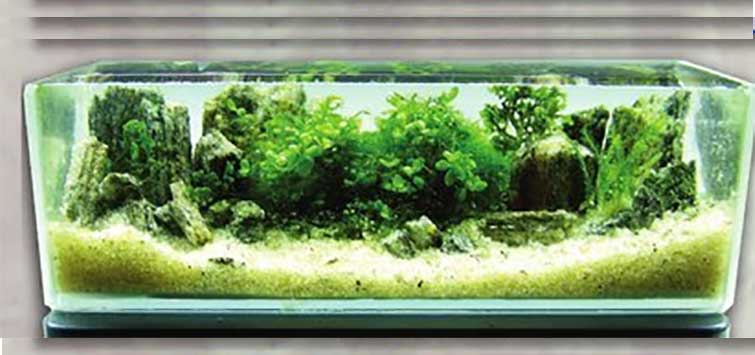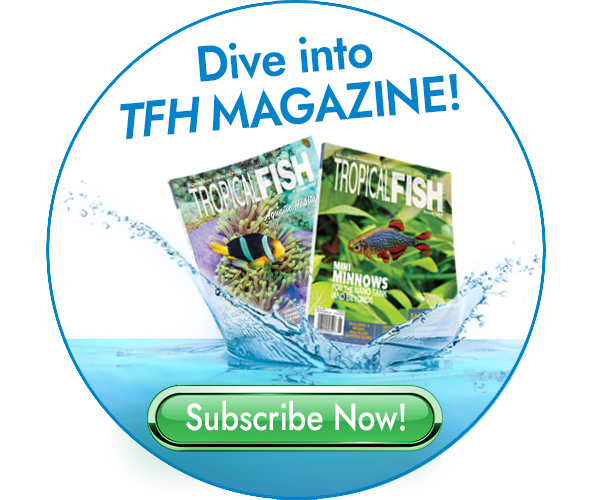Natural Nanos From the Serbian Countryside
Author: Robert Paul Hudson
Establishing a novel and detailed aquascape is no simple task; achieving one in mere milliliters of water is masterful. Innovative aquarist Slobodan Lazarevic does that and more, creating microscopic aquaria that reflect the beauty of real-life nature scenes.
The Art of Miniaturization
Nothing shows greater ingenuity in the art of miniaturization than the extreme planted nano aquarium. It is quite a challenge to find suitable plants and materials to work with that complement such a small-sized setup, yet give the illusion of something much bigger with the intricacies of an aquascape.
For Slobodan Lazarevic, this task comes as naturally as solving a crossword puzzle to relax after a long day of work. “It is strange to me sometimes how aquascaping can divert my full attention from ordinary problems and show me a calm world of silence and creativity,” he told me.
Slobodan has been creating planted aquascapes ranging from less than one liter (a quart) to over 3000 liters (800) for over 20 years. “My wife says I play with plants and aquariums like our son plays with Legos®. She may be right!” He constructs all of his aquariums out of high-quality glass, even the ones that fit in the palm of his hand.
Naturally Inspired
The designs are inspired solely by the outdoors, and while most other prominent aquascapers in the hobby strive to mimic an underwater scene inspired by nature, Slobodan works hard to recreate, in uncanny detail, a landscape scene under water. Rocks are made to look like mountains, moss as trees and bushes, and twigs as tree trunks. “Most of my aquascapes are nothing but my impression of some landscapes I’ve visited, or the reflections of some countryside I still keep in my memory. Of course, my intention is to show the beautiful landscapes of Serbia.” Like any gifted artist, his designs are stored only in his mind and nothing is planned ahead of time—no sketches, no diagrams. He simply sits down and begins work, focusing on the inner picture captured in his thoughts as the point of reference.
Lifespan
The longevity of nanoscapes depends on size. Realistically, he acknowledges that keeping an aquarium that is less than one liter long-term is not feasible. “Usually, ultra nanoscapes last for approximately one month under appropriate care. A good example is my nano iwagumi. It is practically impossible to keep long-term any tank that has only 20 ml [3/4 ounce] of water inside.” At 10 liters (3 gallons), he finds it much easier to maintain water quality and control the growth of plants. “One of my most favorite aquascapes was created at the end of 2007, called Crystal Lake. This aquascape is still in perfect shape today, and I’m convinced that it will be in perfect shape for a long time to come. My decision to redesign some nanoscapes and start over is when plants cannot be easily controlled.”
Maintenance
For a nanoscape to remain pristine looking, it is important to maintain it properly throughout its life. Frequent water changes are important, particularly when no filtration is possible. “I practice daily changes of approximately one-fourth to one-half replacement of water.” He uses water from one of his larger aquariums as the replacement water in his nanos.
At any given moment, he has at least five or six aquascapes to take care of. Maintenance of those aquascapes requires approximately an hour a day, which includes regular water changes, cleaning, and pruning. “That one hour is the most beautiful hour and the best part of my day!”
Materials Are Key
“I’m trying to use available local materials such as sand, rocks, or driftwood in order to make the aquascape as close to an authentic nature representation as possible.”
Finding the right materials (what some people call the hardscape) to complement your vision of your aquascape is essential for its final outcome. Since Slobodan is recreating an actual landscape from his country, he is able to gather material such as rocks, wood, and (in some cases) even plants from the actual site. “My country is full of beautiful rocks. You just need to take a walk and find the right place, and choose from what nature has to offer. I’ve never bought a stone. I live in a big city. Most of my free time I spend in nature, and I travel far away from the city. Every time I find and bring home some interesting material for my hardscape. Each stone represents a specific emotion and reminds me of some wonderful place. Sometimes it is enough to get inspiration.”
It is important to keep these items to the scale of the aquascape so the desired effect can be achieved. He particularly likes using various aquatic mosses for the effect of trees and bushes because of their slow growth rate, and how easily they are shaped and molded. “One of those moss species I usually use in my aquascapes is originally from Serbia.” A variety of plants are used, and each is appropriate for various sizes of the aquarium and aquascape.
Originality
Twenty years ago, Slobodan was first influenced by Takashi Amano and his “Nature Aquarium” style of aquascaping, but contends that now he is influenced only by nature and his own imagination. Being original is very important to him, and he does not want to be compared to anyone else in the hobby. He is not concerned with, and in some cases is unaware of, what style is currently popular in aquascaping.
“All my work in this field is nothing but an attempt to make something original, but at the same time recognizable, as a familiar nature scene in an unfamiliar place—the aquarium.” This is evident from people he has shared photos with on the Internet. He typically receives comments like, “this looks like the mountains of North Carolina,” or “I swear I was just at that place here in Texas!” One of his aquascapes reminds me of a place here in Oregon called Crater Lake. That is what any artist strives for—to stir emotion and evoke personal images into those who look upon it.
After creating dozens of aquascapes, he began to feel it was time to try something different and began the “water under water” series where, along with his familiar mountain scenes, included an artificial lake or body of water. He uses alabaster, glass, or quartz to imitate water. For the Crystal Lake aquascape, he cut and polished a piece of rock to create the unmistakable image of a lake.
Listen, Observe, and Learn
According to Slobodan, the key to his success is a combination of learning through experience, his background in biology, and his creative and artistic ability. “I’m not ashamed to say that I’m still learning...I have a huge aquarium library that contains the most valuable books published in the last 25 years in English, as well as in the Russian language. I’ve continued to read TFH Magazine since 1990.” This hobby has a long tradition in Serbia and the interest in aquascaping is growing. One day he hopes to open an aquarium center where hobbyists can come together and meet. He has his own business breeding freshwater fish and dealing saltwater corals, as well as cultivating plants. All the practical knowledge he has gained from his hobby and business culminate together in his art, which he calls his quiet obsession.
Plant Profile: Pogostemon helferi
Pogostemon helferi was discovered in Thailand and given the name dao noi, meaning “little star.” It has a unique star-shaped leaf cluster that is suitable in the foreground under moderate/bright light. Under low light levels, the plant grows tall with a stem in the center of the plant. Above water, the stems grow long and the star-shaped leaves become small round leaves. This plant has recently become available in the United States.
Plant Profile: Proserpinaca palustris
Known in the United States as marsh mermaid weed (or simply mermaid weed), this plant is native to the southeastern U.S. It goes through a dramatic transformation from its above-water growth form (almond-shaped leaves with serrated edges) to its underwater growth form (deeply grooved and pointed). It grows slowly under bright light and develops various shades of red and orange. Its inimitable appearance bodes well to the creative aquascaper.
Crystal Lake
Dimensions: 38 x 22 x 22 cm (approx. 15 x 9 x 9 inches)
Riccia fluitans
Pogostemon helferi
Hemianthus micranthemoides
Hemianthus callitrichoides “Cuba”
Cladophora aegagrophila
Eleocharis acicularis
Eleocharis parvulus
Heteranthera zosteraefolia
Riccardia graeffei
Vesicularia dubyana
Proserpinaca palustris
El Lazarinjo
Dimensions: 16 x 12.5 x 11 cm (approx. 6 x 5 x 4 inches)
Size: 2 liters (approx. ½ gallon)
Riccia fluitans
Hemianthus micranthemoides
Hemianthus callitrichoides “Cuba”
Proserpinaca palustris
Rotala wallichii
Mayaca fluviatilis
El Poco
Dimensions: 7 x 2.2 x 2 cm (approx. 2¾ x 1 x ¾ inches)
Hemianthus micranthemoides
Cladophora aegagrophila
Riccardia graeffei
Vesicularia dubyana
Lilliputian Meadow
Dimensions: 2.2 x 2.2 x 2.2 cm (approx. 1 x 1 x 1 inch)
Size: Around 8.5 ml
Nano moss Amblystegium serpens
Fissidens sp. from Singapore
Hemianthus callitrichoides
Charming Hill
Dimensions: 12.5 x 9.5 x 9.5 cm (approx. 5 x 4 x 4 inches)
Size: One liter (approx. one quart)
Nano moss Amblystegium serpens
Fissidens fontanus
Serbian mini moss (unidentified moss species)
Mountain Lake
Dimensions: 0.95 x 0.7 x 0.75 cm (approx. 1/3 x ¼ x 1/3 inches)
Size: 500 ml (approx. one pint)
Nano moss Amblystegium serpens
Fissidens sp. from Singapore
Fissidens fontanus
Java moss Taxiphyllum barbieri
Serbian mini moss (unidentified moss species)
Vesicularia dubyana
Hemianthus callitrichoides “Cuba”
Mini Iwagumi
Dimensions: 7 x 2.2 x 2 cm (approx. 2¾ x 1 x ¾ inches); 1-mm-thick glass
Serbian mini moss (unidentified moss species)
Star moss
Fissidens sp.
The Valley of Silence
Dimensions: 65 x 36 x 32 cm (approx. 26 x 14 x 13 inches)
Size: Around 75 liters (20 gallons)
Hemianthus micranthemoides
Vesicularia dubyana
Riccia fluitans
Lilaeopsis brasiliensis
Hemianthus callitrichoides “Cuba”
Proserpinaca palustris
Hottonia palustris
Microsorium pteropus “Windelov”
Nano moss Amblystegium serpens
Heteranthera zosteraefolia
Eleocharis parvulus
See the full article on TFH Digital http://www.tfhdigital.com/tfh/200906/#pg67

.png?h=595&iar=0&w=2781&hash=5FD5E69473BCC22199FBFA2FB71B6033)



